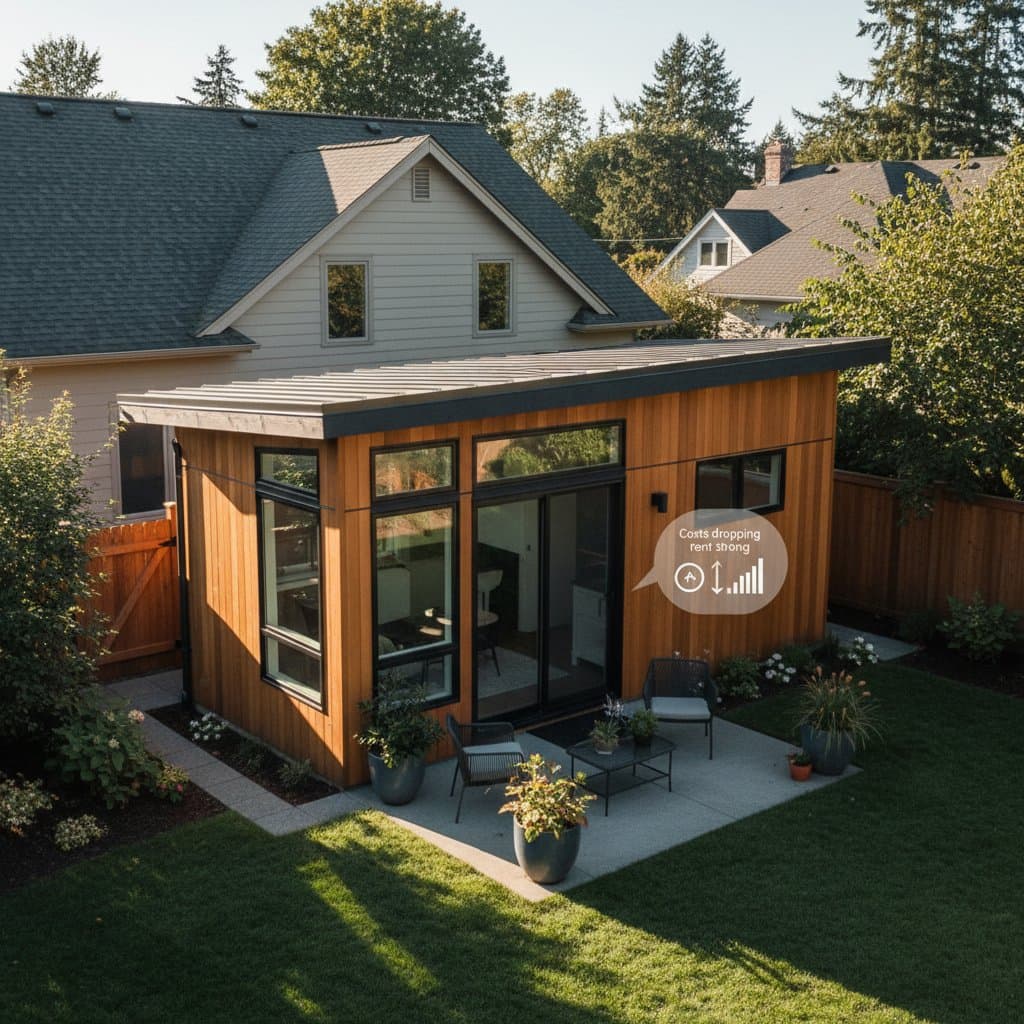Understanding 2025 Costs for Building a Granny Flat
Homeowners often underestimate the investment required for a granny flat, formally known as an accessory dwelling unit or ADU. These compact residences, constructed on the same property as the primary home, serve diverse purposes such as housing extended family or generating rental income. In 2025, expect to invest between $120,000 and $350,000 for a fully finished, code-compliant unit, with the national median hovering at approximately $220,000 for a standard detached model. Factors like location-specific regulations, site topography, and customization levels drive these variations.
Defining a Granny Flat
A granny flat functions as a self-contained living space, complete with its own entrance, kitchen, bathroom, and sleeping area. Configurations include attached additions to the main house, standalone detached units, or structures elevated over an existing garage. Compliance with local zoning ordinances remains essential, dictating maximum square footage, required setbacks from property boundaries, and connections to utilities like water and electricity. Typically, these units range from 400 to 1,200 square feet, balancing functionality with spatial constraints.
Indicators That You Are Prepared to Proceed
Consider building a granny flat if certain conditions align with your needs and property.
- Extended family requires dedicated living quarters for aging parents or visiting relatives.
- Municipal zoning permits accessory dwelling units without restrictive overlays.
- Your lot offers at least 400 square feet of usable, level yard space free from easements.
- Existing utilities allow straightforward extensions, minimizing excavation needs.
- You intend to occupy the property for five years or longer to realize returns via rent or appreciation.
Assessing these elements early prevents costly surprises and streamlines the planning phase.
Navigating the Construction Process Step by Step
Embarking on a granny flat project demands a structured approach to achieve efficiency and adherence to standards. The timeline generally spans four to twelve months, depending on complexity and permitting delays.
- Verify zoning and setback requirements. Contact your local planning department to review ordinances, plot coverage limits, and any neighborhood association rules.
- Engage a qualified designer or architect. Professionals draft detailed blueprints that incorporate site-specific features while satisfying building codes.
- Submit permit applications. Secure approvals for construction, electrical installations, plumbing systems, and potential environmental or grading assessments.
- Conduct site preparation. Remove obstacles, grade the terrain, extend utility lines, and establish a stable foundation, such as a concrete slab or elevated piers.
- Erect the core structure. Install framing, roofing materials, energy-efficient windows, secure doors, and protective exterior siding.
- Complete interior installations. Incorporate insulation for thermal efficiency, drywall for walls, durable flooring options, custom cabinetry, and essential fixtures like lighting and appliances.
- Undergo final inspections. Authorities evaluate the entire build for safety and compliance, issuing a certificate of occupancy upon approval.
Throughout this sequence, maintain open communication with your contractor to address unforeseen issues promptly.
Breaking Down Costs and Influencing Variables
Budgeting accurately requires dissecting expenses across key categories. The table below outlines typical ranges for 2025, based on standard 600- to 800-square-foot units in moderate climates.
| Line Item | Typical Range | Notes |
|---|---|---|
| Design and permits | $8,000 - $25,000 | Encompasses architectural drawings, structural engineering, and municipal filing fees. |
| Site prep and foundation | $15,000 - $50,000 | Covers land clearing, soil testing, utility trenching, and foundation pouring or piling. |
| Framing and exterior | $40,000 - $100,000 | Includes lumber framing, shingled or metal roofing, insulated windows, entry doors, and weather-resistant cladding. |
| Interior finish | $30,000 - $80,000 | Features kitchen countertops, resilient vinyl or hardwood flooring, bathroom vanities, and neutral paint applications. |
| Utilities | $10,000 - $40,000 | Involves water line extensions, septic or sewer connections, electrical panel upgrades, and heating, ventilation, and air conditioning systems. |
| Total range | $120,000 - $350,000 | National median approximately $220,000; varies by region and scale. |
Elevated expenses often stem from challenging terrains requiring retaining walls, distant utility hookups necessitating extensive piping, premium materials like quartz surfaces or solar integrations, or intricate architectural elements such as vaulted ceilings. Opting for prefabricated or modular construction can reduce overall outlays by 10 to 20 percent through factory efficiencies and reduced on-site labor.
Weighing DIY Approaches Against Professional Services
While cost savings tempt some toward do-it-yourself efforts, the complexities of ADU construction favor expert involvement. The comparison table highlights critical distinctions.
| Factor | DIY Approach | Professional Approach |
|---|---|---|
| Skill level | Demands proficiency in carpentry, electrical, and plumbing trades | Relies on certified specialists with relevant licenses |
| Safety risk | Substantial exposure to hazards like falls, shocks, and structural failures | Mitigated through insurance, safety protocols, and equipment |
| Tools required | Extensive inventory including excavators, nail guns, and pipe benders | Supplied and maintained by the construction firm |
| Permit compliance | Owner bears full responsibility for meeting codes | Contractor manages submissions and inspections |
| Time commitment | Often extends to 10-12 months due to learning curves | Streamlined to 4-8 months with coordinated teams |
| Warranty coverage | Lacks formal guarantees on quality | Includes at least one-year protection on labor and materials |
Novice attempts risk code violations, safety breaches, and diminished property value. Delegate structural, electrical, and plumbing tasks to licensed professionals to safeguard investments.
Prioritizing Safety and Regulatory Compliance
Construction sites pose inherent dangers, so equip workers with helmets, gloves, sturdy boots, and eye protection. Maintain barriers around excavations and deactivate power sources during wiring. Essential safety features in every granny flat include hardwired smoke detectors, carbon monoxide alarms in sleeping areas, and operable egress windows measuring at least 5.7 square feet. Jurisdictions may mandate fire-resistant barriers separating the ADU from the main house and enforce minimum separations from lot lines to prevent fire spread.
Ensuring Longevity Through Maintenance
Quality craftsmanship extends a granny flat's service life to 50 years or beyond with routine care. Schedule annual evaluations of the roof for shingle wear and drainage systems for clogs. Perform gutter cleanings biannually to avert water damage. Swap HVAC filters quarterly to optimize air quality and efficiency. Budget for exterior repaints and sealant reapplications every five to seven years to combat weathering. Document all upkeep activities meticulously, as these records bolster resale appeal by demonstrating diligent ownership.
Securing Financing and Maximizing Returns
Funding options for granny flats include home equity loans, construction-to-permanent mortgages, or personal lines of credit, often with favorable rates for value-adding improvements. Calculate potential yields by estimating rental rates at 1 to 2 percent of the property's total value monthly, or anticipate a 10 to 20 percent uplift in overall home appraisal upon completion. Consult financial advisors to align the project with long-term goals, ensuring the addition enhances both lifestyle and financial security.



